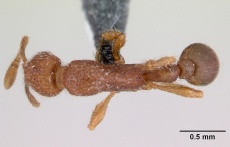Tyrannomyrmex dux
| Tyrannomyrmex dux | |
|---|---|

| |
| Tyrannomyrmex dux | |
| Scientific classification | |
| Kingdom: | Animalia |
| Phylum: | Arthropoda |
| Class: | Insecta |
| Order: | Hymenoptera |
| Family: | Formicidae |
| Subfamily: | Myrmicinae |
| Tribe: | Solenopsidini |
| Genus: | Tyrannomyrmex |
| Species: | T. dux |
| Binomial name | |
| Tyrannomyrmex dux Borowiec, 2007 | |
This species is known from a single holotype worker collected in a leaf litter sample from Kerala state, southern India.
Identification
Borowiec (2007) - T. dux is most easily distinguished from Tyrannomyrmex rex by the differences in pilosity, sculpture and the shape of the petiole. T. rex is almost lacking pilosity on the mesosoma, while its whole surface is covered with erect hairs in T. dux. Also the sculpturation is stronger in T. dux, especially on the mesosoma. While in T. rex foveae on the mesosoma are small with most interspaces equal or wider than their diameter, T. dux has them deeper, larger, irregular and almost touching each other. Also, the petiole in T. rex is stout with a big node and short peduncle, while in T. dux the node is more slender, much lower than long.
Tyrannomyrmex dux agrees well with this generic diagnosis (Fernandez 2003) but the setae on the venter of the mandibles appear simple, not modified, and similar in structure to other setae of body. Though the sting is also extruded in T. dux, it is not as long as in T. rex. Thus at least characters 2) and 12) given by Fernandez are not universal throughout Tyrannomyrmex.
Keys including this Species
Distribution
Distribution based on Regional Taxon Lists
Oriental Region: India (type locality).
Distribution based on AntMaps
Distribution based on AntWeb specimens
Check data from AntWeb
Countries Occupied
| Number of countries occupied by this species based on AntWiki Regional Taxon Lists. In general, fewer countries occupied indicates a narrower range, while more countries indicates a more widespread species. |

|
Estimated Abundance
| Relative abundance based on number of AntMaps records per species (this species within the purple bar). Fewer records (to the left) indicates a less abundant/encountered species while more records (to the right) indicates more abundant/encountered species. |

|
Biology
Castes
Known only from the worker caste.
Images from AntWeb

| |
| Holotype of Tyrannomyrmex dux. Worker. Specimen code casent0178233. Photographer April Nobile, uploaded by California Academy of Sciences. | Owned by UWCP, University of Wroclaw, Wroclaw, Poland. |
Nomenclature
The following information is derived from Barry Bolton's Online Catalogue of the Ants of the World.
- dux. Tyrannomyrmex dux Borowiec, M.L. 2007a: 66, figs. 1-4 (w.) INDIA (Kerala).
- Type-material: holotype worker.
- Type-locality: India: Kerala, Ponmudi hill resort, 30 km. N Trivandrum, 8°46’N, 77°06’E, ca 1300-1500 m., 28-30.vi.1999 (Z. Kejval & M. Trýzna).
- Type-depository: DBET.
- Status as species: Alpert, 2013: 287 (in key); Bharti, Guénard, et al. 2016: 48;Sadasivan & Kripakaran, 2017: 275 (in key).
- Distribution: India.
Unless otherwise noted the text for the remainder of this section is reported from the publication that includes the original description.
Description
Worker
HW 0.52, HL 0.71, EL 0.05, SL 0.56, PrW 0.49, WL 1.03, PL 0.39, PPL 0.21, PW 0.22, PPW 0.31, GL 0.77, TL 3.11, CI 73, SI 107.
Head longer than wide, sides and posterior outline slightly convex. Posterior head corners rounded. Mandibles triangular, masticatory margin edentate except two blunt apical teeth. Palp formula undeterminable. Clypeus convex in anterior part, posteriorly narrowly inserted between frontal lobes. Clypeus lacking carinae. Frontal lobes present and short but prominent, rounded and obscuring antennal sockets. Antennae 11-segmented with feebly defined three segmented club, apical segment being largest and equal in length to rest of funiculus, excluding pedicel. Scape slightly longer than head width, shallowly curved at base. Eyes small, composed of a few feebly defined ommatidia and situated slightly anterior to midlength of head (at 45% of HL).
Mesosoma devoid of any kind of grooves or sutures, in side view forming a single broad and continuous convexity. In dorsal view it is widest in promesonotal area, slightly decreasing in width posteriorly. Anteroventral corner of pronotum rounded. Propodeal spiracle round and situated at distance about 3,5 diameters from propodeal margin. Propodeum armed with two very small, triangular, and acute teeth. Metapleural lobes broad, more or less rounded. Metapleural gland orifice not seen at 110X. Petiole without clearly differentiated node or peduncle, node lower than long, in dorsal view longer than wide. Postpetiole wider than long; postpetiolar sternite with transverse keel anteriorly, forming acute tooth in lateral view.
Head and mesosoma heavily foveate. Foveae dense, irregular, usually less than 1/3 their diameter apart. Interspaces between foveae smooth and shining on head, sides of promesonotum and dorsal surface of mesosoma; those on katepisternum and sides of propodeum very feebly shagreened, appearing matt. Sculpture of petiole consisting of microreticulum in most of anterior part and irregular foveae on postero-dorsal surface. Sculpture of postpetiole microreticulate. Gaster covered with microreticulum fading before half length of first gastral tergite, remainder of gaster smooth.
Body pilosity dense and abundant, composed of many erect hairs present on the head, meso- and metasoma; hairs on head and mesosoma arising from centers of foveae. Abundant hairs also present on body appendages, being present on antennal scape as well as funiculus; hairs present on all leg segments and on both dorsal and ventral surfaces of mandibles; those on ventral surface not differing visibly in structure from rest of pilosity. Body color reddish, appendages yellowish.
Type Material
Holotype deposited in the Department of Biodiversity and Evolutionary Taxonomy, Zoological Institute, University of Wroclaw, Przybyszewskiego 63/77, 51-148 Wroclaw, Poland. Holotype worker bears the following labels: white printed label ‘S-INDIA, Kerala state, Ponmudi hill resort, 30 km NE of Trivandrum, 77°06'E 8°46'N, ca 1300-1500m, 28-30.vi.1999, Z. Kejval & M. Trýzna leg.’ and red, printed, edged in black, label ‘HOLOTYPUS Tyrannomyrmex dux des. M. L. Borowiec 2007’.

